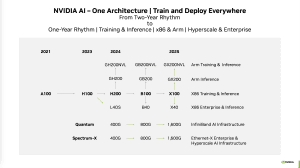Werbung
Im Rahmen der Bekanntgabe der Quartalszahlen (PDF) hat Dells Chief Operating Officer Jeff Clarke einige interessante Aussagen zu zukünftigen KI-Beschleunigern von NVIDIA gemacht. Diese passen ganz gut in das, was NVIDIA höchstselbst Mitte Oktober veröffentlicht hat. Die Kadenz zwischen den einzelnen Beschleuniger-Generationen wird sich erhöhen, teilweise sprechen wir nicht von komplett neuen Chips, sondern beispielsweise von einem Update auf neuen schnelleren und größeren Speicher – so geschehen von H100 auf H200 und von GH100 auf GH200.
Aktuell liefert NVIDIA vor allem H100-Beschleuniger aus. Als H200 und GH200 werden diese mit HBM3E bestückt in diesem Jahr eine größere Rolle spielen. Noch im zweiten Halbjahr soll der Nachfolger B100 (Blackwell) folgen. Die entsprechenden ARM+GPU-Ableger GB200 und GB200NVL stehen ebenfalls auf der Liste.
Offiziell sprach NVIDIA darüber hinaus nur als X100, GX200 und GX200NVL über einen Blackwell-Nachfolger. Dell bringt nun aber auch noch einen Zwischenschritt, den B200-Beschleuniger zur Sprache.
Obviously, any line of sight to changes that we're excited about what's happening with the H200 and its performance improvement. We're excited about what happens at the B100 and the B200, and we think that's where there's actually another opportunity to distinguish engineering confidence. Our characterization in the thermal side, you really don't need direct liquid cooling to get to the energy density of 1,000 watts per GPU.
That happens next year with the B200. The opportunity for us really to showcase our engineering and how fast we can move and the work that we've done as an industry leader to bring our expertise to make liquid cooling perform at scale, whether that's things in fluid chemistry and performance, our interconnect work, the telemetry we are doing, the power management work we're doing, it really allows us to be prepared to bring that to the marketplace at scale to take advantage of this incredible computational capacity or intensity or capability that will exist in the marketplace.
Was es mit B200 auf sich hat, wird allerdings nicht erläutert. Es könnte sich um einen ähnlichen Zwischenschritt bei H100 und H200 handeln.
Dell erwartet nicht, dass die Leistungsaufnahme signifikant steigen wird. Als SXM5-Modul kann sich ein H100-Beschleuniger eine maximale Leistungsaufnahme von 700 W genehmigen. Für die MI300X- und MI300A-Beschleuniger gibt AMD beispielsweise 750 W, bzw. 760 W an. Auf bis zu 1.000 W können NVIDIAs GH200-Beschleuniger konfiguriert werden.
Dell geht nicht davon aus, dass NVIDIA die TDP seiner Beschleuniger weiter erhöhen wird. Derzeit geht man von 1.000 W aus. Diese 1.000 W lassen sich noch relativ problemlos kühlen, zumal die Packages inzwischen entsprechend groß sind somit die Abwärme pro Fläche noch nicht wirklich problematisch ist.
NVIDIA wird vom 18. bis 21. März seine Hausmesse GTC abhalten. Wir werden vor Ort sein und erwarten entsprechend weitere Details.

